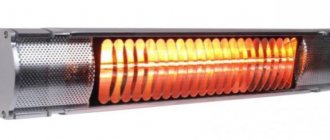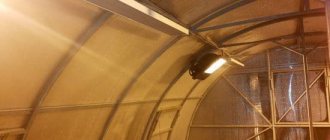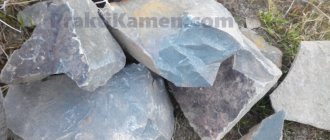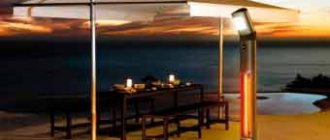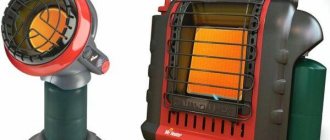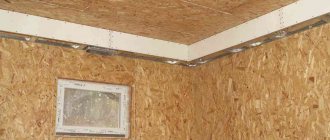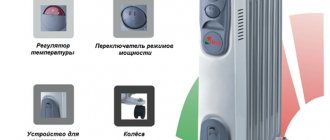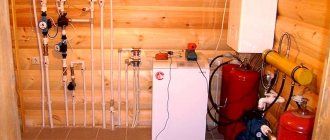Infrared heaters and convective heating: operating principle
What is the difference between heating a room with an infrared ceiling heater and heating with convectors?
With convective heating, warm air, which is heated by interaction with the device, rushes upward, and cold air takes its place. Thus, the air higher up towards the ceiling is much warmer than near the floor. Accordingly, no convector can heat a room instantly; for this it will take time, since the air in the near-ceiling area must heat up first.
The case with infrared heaters is exactly the opposite. With such heating of the room, on the contrary, it will be warmer below than above, and closer to the ceiling the air temperature decreases, which, in fact, is an undoubted advantage of infrared heating. How do infrared heaters work? These devices do not heat the air at all; their action is directed at objects in the room, as well as at the walls and ceiling: absorbing infrared rays, they heat up.
The principle of operation of the system is compared to the operation of the sun: the infrared waves that heat the room correspond to the range of radiant energy of the luminary. Consequently, heat is felt immediately after turning on the heater, although not in the entire room, but of a local nature, that is, in that very place of radiation.
Features of IR heating
IR heaters are widely used in various rooms. Depending on the installation location, devices are of the following types:
- Wall-mounted IR batteries replace the traditional heating system and are produced in the form of radiators, baseboards, and stylish panels; prevent the formation of mold. The disadvantages include high cost, poor heating of the room in frosty weather.
- Floor systems are easy to install, not dangerous in terms of fire, have a long service life, and prevent dampness in the room. Disadvantages include selectivity of installation locations; it is necessary to cover the structure with materials that conduct heat.
- Compact devices are usually installed on the floor. Mobility allows you to move the device from place to place.
- Ceiling infrared heaters are also popular.
The whole truth and myths about them are as follows:
- Misconception No. 1: This technique is dangerous in itself. In fact, just as we are not afraid of the sun, we should not be afraid of an infrared heater either; prolonged intense exposure to short waves can cause harm to health.
- Misconception #2: Burning oxygen. Experts prove that modern devices do not create conditions for the combustion of a chemical element. The burning smell comes from settled household dust. Any device that increases the air temperature in the room dries it out, this also applies to the central heating radiator. Therefore, in winter, to create a healthy microclimate, it is recommended to use a humidifier.
The advantage of the design is that the energy rushes down, a “clump” of heat is created in the necessary places.
Advantages of heaters
Many people are interested in whether infrared heating is harmful to humans. Experts say: devices with electromagnetic radiation are beneficial provided that all components are produced with high quality. In this case, the advantages are:
- absence of released toxins;
- the ability to quickly warm the required area;
- silent operation;
- ease of installation;
- create a microenvironment that is harmful to the fungus;
- safety of the device, the surface of which does not heat above 46 degrees;
- economical energy consumption.
According to experts, systems with infrared rays also have disadvantages; infrared heaters are harmful to humans if they are used incorrectly.
How to avoid negative influences
For safety reasons, infrared heating should be installed correctly; otherwise, the harm to health may be significant. Experts do not recommend installing the system on ceilings in a child’s room. You should not sleep under these reflectors; this can lead to poor health, migraines, nausea and heat stroke.
The harmfulness of such a source of rays lies in the “burning” effect. When the skin heats up, it does not have time to sweat and becomes dry. Intense exposure can cause burns. This is especially dangerous for the eyes; when heated, the lens and retina are damaged, and there is a risk of cataracts.
If you imagine how chicken is baked under the grill, you can understand what will happen to the skin under prolonged exposure to short infrared rays. Therefore, it is recommended to choose a heating device in the medium and long wave range of 50−200 microns.
Heaters with halogen and carbon elements have a negative impact on health; instead, it is better to choose sources with a ceramic body.
Choosing an infrared heater: what is important to know
What should you consider when choosing a ceiling infrared heater?
- Firstly, it is important to decide whether this type of heater will be used as a basic one or will its function only be additional heating of the room? That is, before making a choice, you need to take into account the purpose of using the device and the intensity of its work.
- Secondly, it is advisable to take into account the technical characteristics of the room for which the device is selected. For example, you need to pay attention to the walls (how thick are they, are they insulated from the outside), the ceiling (there is an apartment or roof on top (if there is a roof, then what condition is it in and what is the quality of insulation); windows (what kind of windows are in the room, how tightly the glass is in contact with the frame), etc. The combination of these factors has a direct impact on the heat loss of the room, therefore, these characteristics determine the choice of heater.
- Thirdly, it is important to decide which manufacturer’s product will be the best. As a rule, they choose a product from the brand that has proven itself to be the best and where the price corresponds to the quality. Advice from friends and acquaintances regarding this or that brand can also help in resolving the issue. And, of course, no one excluded reviews about the product on the Internet. They may not create a complete picture, but they will give a general idea.
Domestic brand IR heaters
Speaking about infrared heaters, one cannot fail to mention the domestic brand “Peony”. If you believe the advertising, this technique is high class. It has a fundamentally new design: the dispersion angle of long waves is greater than that of most brands from other manufacturers. In addition, “Peony” is fireproof and does not make unnecessary noise, which is the problem with many infrared heaters. Infrared radiation plates of this brand are quite reliable and, as the manufacturer assures, have a longer service life than other brands. In addition, Peony has an exquisite design and is relatively inexpensive.
To consider installing a ceiling infrared heater, you can use this brand as an example.
Types of infrared heaters
Globally, we will divide infrared heaters into four types;
- Halogen.
- Carbon.
- Quartz.
- Mycothermal.
The key property of the listed types of equipment is that the devices emit predominantly heat. The share in the total return is at least 80%. For comparison, convectors emit almost no radiation; the bulk of the heat is carried away by the passing air flow. Oil heaters work in a similar way.
Quartz
How the property of radiating is implemented in practice. The idea was given by the Sun. The giant ball heats the Earth using radiation. The radiation passes through a vacuum, enters the atmosphere, is partially extinguished, and reaches the surface of the earth. The air heats up slightly. Objects receive heat. It’s cold in the desert at night—sand doesn’t retain energy.
An infrared quartz heater works similarly. Let's call the tungsten spiral the Sun. The radiation passes through a vacuum and is partially filtered by the quartz glass of the bulb. Only objects receive the heat from an infrared heater. Transparent walls absorb part of the energy, and we observe the phenomenon of convection.
The choice of quartz is justified. There is reason to believe that the crystal transmits the emission spectrum of the tungsten filament, which lies predominantly in the infrared region, better than typical glass. To achieve maximum effect, a temperature of 450-500 ºC Celsius is required. This is done relatively simply in a vacuum, where the heat has nowhere to go.
Halogen heaters
In this case, gas takes the place of vacuum. Halogens are called poisons: they kill in small quantities and irreversibly injure the body. Iodine in its pure form is poison. People are so accustomed to being treated with the element that is part of thyroxine that it is difficult to believe how dangerous iodine is in its pure form. The vapors of the substance are lethal.
Halogen heaters use inert gas halides, which are harmless to humans in the amount pumped into the heater.
Why is gas needed inside a quartz flask? There are two reasons:
- Vacuum reduces the strength of the flask. The walls have to be made thick, reducing the efficiency of the device. During physics lessons they showed photographs of interesting experiments. The tank was filled with steam and, as it cooled, it was crushed into a cake by atmospheric air pressure. Thick steel bent like paper. Vacuum is more destructive; in an infrared heater, the bulb is not made of steel, but of glass.
- Wise scientists made it so that tungsten ions, when trying to leave the heating coil, do not settle on the walls of the glass flask. They come back, extending the life of the infrared heater.
Carbon heaters
Carbon spirals are better, they do not collapse under the influence of temperature. Such infrared heaters have advantages and no disadvantages.
Micathermic heaters
Mica-coated plates gave their name to a group of household appliances. Details have not been disclosed, but 80% of the energy turns into rays, which will classify the curious device as an infrared emitter.
It does not burn out air, has the appearance of a convector on wheels, and is protected on all sides by fine-mesh grilles. These infrared heaters are popular with sellers. Buyers are still just looking around. You can't hang it on the wall, the size is too big, but the impact is good.
Installation of a ceiling infrared heater (using the example of the Peony brand)
There are several simple rules that should not be forgotten when installing a ceiling infrared heater:
- Safe fastening is the first prerequisite. It must hold the device securely and not deform.
- It is best to install the heater using the fasteners that come with the device.
- The heating surface of the device must not come into contact with materials that may ignite.
- Wires must be insulated for safety reasons.
What is included in the “Peony” ceiling infrared heater kit? Actually, the heater itself, installation kit, operating instructions, warranty. Thermostats must be purchased separately.
What is a heater? This is a device about half a meter long under the ceiling, to some extent resembles a lamp, but does not glow. Only a small light is on while the device is operating, but if it is turned off, the device, accordingly, does not work - it’s like an indicator.
The manufacturer assures that even an inexperienced beginner can install the heater. The hooks are screwed to the ceiling, chains are hung on them, and there is a groove on the heater where these chains need to be inserted. The user can adjust the size of the chain at his own discretion. Of course, if the ceiling is wooden or suspended, installing the device will be easier than if the ceiling is concrete and the ceiling will have to be drilled. However, the hangers are generally quite easy to install. The wires are secured using a terminal box, which is covered with a protective casing.
Thermostats that can be used in conjunction with a heater can be mechanical or electrical. There are no questions with mechanical regulators: you just need to set a certain temperature. The situation with electric ones is more interesting: they can be programmed, for example, for a week. Some electric thermostats allow you to set only basic parameters. Others can be reprogrammed entirely according to the user's wishes. Although such thermostats are used quite rarely, and this is not only due to possible difficulties in setting them up. The price category of electric thermostats scares off even connoisseurs of their enormous capabilities.
The infrared heater also provides the ability to use a thermostat (although it is not included). This creates additional convenience for the user: the heater will not work 24 hours a day. The thermostat will turn on the heater when needed.
The best ceiling heaters
In the category of ceiling heaters, the following models are widely used:
- Almac IK8;
- Peony Thermoglass Ceramic-10.
Let's take a closer look at their description and some technical parameters.
Almac IK8
Can be used as a main or additional heat source. The body of the model is made of high-quality aluminum and is equipped with a low-temperature heating element. Fixation to the ceiling is carried out using special fasteners that come with the heater.
| Power | 800 W |
| Size | 980x160x30 mm |
| Weight | 2.4 kg |
| Room area | 10 m² |
| Number of modes | 1 |
| Installation height | 2.2 m |
Cost: from 3,200 to 4,300 rubles.
pros
- aluminum body;
- the top layer consists of heat-resistant paint;
- The kit includes the parts necessary for installation;
- current is 3.6 A;
- In order to accurately regulate the temperature, an additional connection of a thermostat is allowed.
Minuses
- The white color of the body quickly attracts dirt.
Friends recommended me to buy. They always use infrared models because they work much better than simple ones and do not take up much space. In addition, with their help it is possible to easily dilute the interior. I did not have any comments regarding the operation of the device. Really effective at what she does. A big plus is the almost silent operation. I can confidently recommend purchasing!
Almac IK8
Peony Thermoglass Ceramic-10
The model is made of tempered glass. Its installation requires the mandatory installation of a thermostat, which is not included in the kit. Two installation methods are allowed: ceiling and wall. Mounts are not included in the kit and must be purchased separately. The operation of the device is based on balanced convection. Due to the absence of any coating on the heater, the possibility of odor during operation is completely eliminated.
| Voltage | 220 V |
| Maximum power | 1000 W |
| Heating area | 20 m² |
| Weight | 4.6 kg |
| Installation height | 2.5 – 3.5 m |
Price: from 4,000 to 5,000 rubles.
pros
- large heating area (20 m²);
- power indicator allows you to achieve efficient operation;
- light weight;
- easy installation.
Minuses
- The kit does not include mounting brackets or a thermostat.
The heater described earlier does its job perfectly. I didn’t install it on the ceiling because I wanted to save space in the room. On ordinary days it is easy to confuse it with a lamp, but in cold weather it begins to work and fill the entire room with warmth and even the next one. Management is as simple as possible and does not require any additional knowledge. Among other things, it is worth mentioning the low weight of the structure, which facilitates the installation process and subsequent transportation. We were completely satisfied with the purchase and results of use. We recommend it to others!
Peony Thermoglass Ceramic-10
Rules for using an infrared ceiling heater
In fact, caring for ceiling heaters is very basic: all you need is to periodically wipe them from dust.
Infrared rays are not harmful to the human body, some even claim that they have a positive effect on health. However, it is not recommended to stay in direct light for long periods of time. Since the principle of operation of an infrared heater is similar to the operation of the sun, if you stay under the “artificial sun” for a long time, you can quite reasonably get a heat stroke. Accordingly, you should not use very powerful devices in a room with a small square footage. It is important to adhere to the following rule: it is better to have more infrared heaters with low power than one with high power.
Ceiling short-wave heaters are also not recommended: short waves can penetrate the body and be harmful to health.
